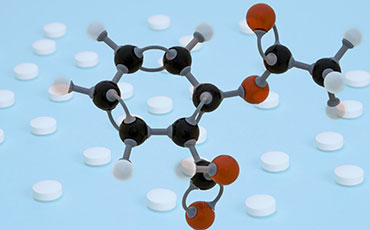 How many tablets have you taken this week? Whether it is for pain relief, high blood pressure or diabetes, Britons are taking more medicines than ever before – in 2012 over one billion prescription items were dispensed, many of them in tablet form. Coupled with over-the-counter medicines, it is estimated that the average person will swallow 40,000 pills over their lifetime, an average of more than one a day. It is also big business – the pharmaceutical industry ranks second only to finance in terms of its contribution to the UK economy. Mathematical pharmaceutical research alone added £16 billion to the country’s coffers in 2010.
How many tablets have you taken this week? Whether it is for pain relief, high blood pressure or diabetes, Britons are taking more medicines than ever before – in 2012 over one billion prescription items were dispensed, many of them in tablet form. Coupled with over-the-counter medicines, it is estimated that the average person will swallow 40,000 pills over their lifetime, an average of more than one a day. It is also big business – the pharmaceutical industry ranks second only to finance in terms of its contribution to the UK economy. Mathematical pharmaceutical research alone added £16 billion to the country’s coffers in 2010.
However, despite tablets playing a daily role in our lives, we just assume they will do the job and we think little about the process that transformed a molecule into today’s useful medicine – a process in which mathematics plays a significant role.
That process starts with the need to alter the behaviour of a particular biological target, often starting or stopping a particular protein from functioning in order to provide some benefit to the patient. Once researchers have found a chemical (molecule) that can affect a particular biological target, it has to be developed into product that a patient can take. This has to be done as quickly and efficiently as possible so that patients can reap the benefits, but the process also needs to have minimal environmental impact and adhere to the strict rules within the highly regulated pharmaceutical industry. The tablet must also be reproducible – typical tablet presses churn out a minimum of 100,000 tablets an hour.
In order to reach the biological target, any pill needs to have a stable structure that can deliver the active ingredient(s) into your bloodstream. Individual molecules are not stable enough and often fall apart. Crystalline structures, where the molecules are arranged into a crystal containing a repeating pattern of molecules, are much more stable and the crystallisation process naturally minimises impurities in the active pharmaceutical ingredient and in the product.
The mathematics behind fitting shapes most efficiently into a fixed space dates back centuries and is known as a “packing problem”. Seventeenth century astronomer Johannes Kepler, for example, suggested that the best way to pack spheres together is in a pyramid-like tower, similar to the way greengrocers stack their oranges. However, the wait for
a mathematical proof of Kepler’s conjecture would last until 2003.
The trouble is that the shapes of the molecules involved in medicines are much more complex than spheres and there are many thousands of ways to arrange them into crystals. Which is the most effective? Pharmaceutical companies, including Pfizer, use mathematical algorithms to sort through this myriad of possibilities and cherry-pick the top contenders based on the most stable packing energy.
To help improve confidence in the crystal’s stability, Pfizer drug product designers cross-check their top contenders with the Cambridge Structural Database which contains around 600,000 known crystalline structures. Using the mathematics of pattern recognition, they can see how often a similar pattern has worked before. If not utilised very often, or never, there is probably a reason for that and there are more stable arrangements to be had. Equally, the pattern recognition analysis could reveal that there are more common variations of a particular crystal structure. Mimicking those variations by tweaking the way the molecules in the crystal interact together increases stability.
 Up to this point no real-world crystal has been created because the best solutions have been selected ‘virtually’ first. This optimisation process, in which mathematics plays a big part, saves both time and money. However before the drug can be used the molecules have to be assembled for real into the chosen crystalline structure to form a white powder. Impurities, where the wrong type of molecules stray into the structure, or defects, where the crystal’s structure doesn’t repeat perfectly, can alter both the safety and efficacy of the treatment and so have to be carefully monitored throughout this process.
Up to this point no real-world crystal has been created because the best solutions have been selected ‘virtually’ first. This optimisation process, in which mathematics plays a big part, saves both time and money. However before the drug can be used the molecules have to be assembled for real into the chosen crystalline structure to form a white powder. Impurities, where the wrong type of molecules stray into the structure, or defects, where the crystal’s structure doesn’t repeat perfectly, can alter both the safety and efficacy of the treatment and so have to be carefully monitored throughout this process.
Once drug developers are satisfied, the white powder is fashioned into a tablet that can be administered (in clinical trials to start with). However, the white powder – or active ingredient – isn’t the only component of the finished pill. Other benign ingredients – called excipients – are needed into order to bind the powder together, help it flow during the manufacturing process, and make it more compressible and less likely to fall apart when removed from the tablet press. Along with adding these benefits, the excipients must not prevent the tablet from being hard or quickly dissolved when swallowed. How dense the final granules end up in the finished product and the uniformity of the distribution of the active ingredient can be calculated beforehand by accounting for factors such as the quantity of “binder” used to combine the active ingredients to the excipients, how much mechanical energy is used to compress it into a tablet, the size of the active particles and the dose.
So next time you swallow a pill, spare a thought for the years of painstaking development that went in to making it work, and the mathematics that made it all possible.
Technical Supplement
Kepler’s conjecture
In the seventeenth century Johannes Kepler studied the most efficient way to pack spheres of equal size into three dimensional space. He conjectured that the best way to do it is to use a face-centred cubic lattice – a similar arrangement to how greengrocers stack oranges. Spheres will fill 74% of space when arranged in this manner.
However, conclusive mathematical proof that spheres could not pack more than 74% of space would wait for centuries. In 1998 American mathematician Thomas Hales provided a proof by exhaustion – he used a computer programme to check through as many different arrangements as possible. He didn’t find a more efficient way to pack spheres. However, the ‘proof’ runs to 250 pages and three gigabytes of data and the twelve academic referees who reviewed Hales’s work could not comment on the validity of every single stage of the mammoth calculation. Instead they said they were 99% certain it was correct.
The IMA would like to thank the team at Pfizer for their help in the preparation of this document.
Printable Version
Download a printable version of this paper here:
Pharmaceuticals from Molecules to Medicine



